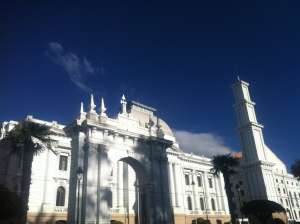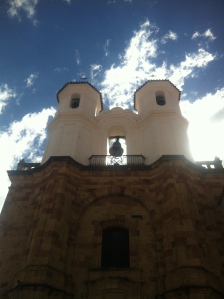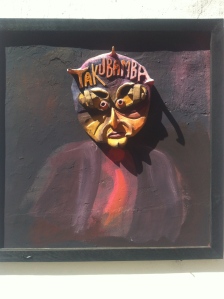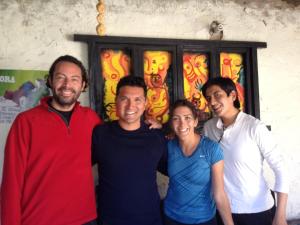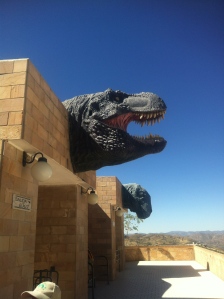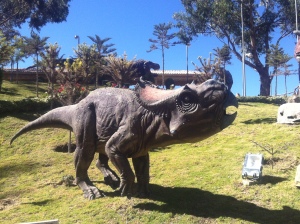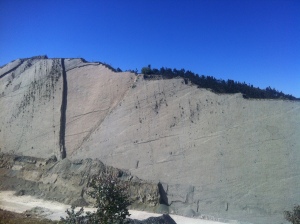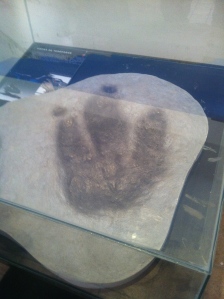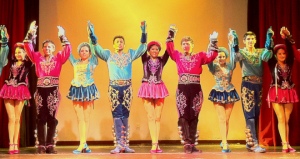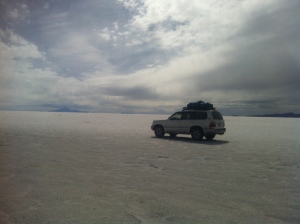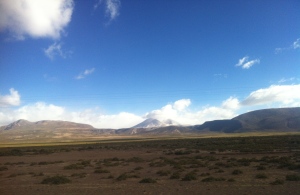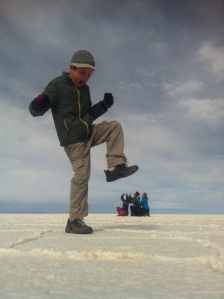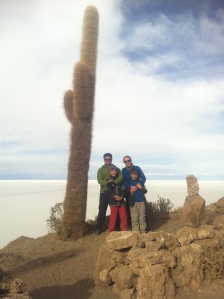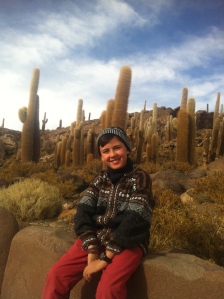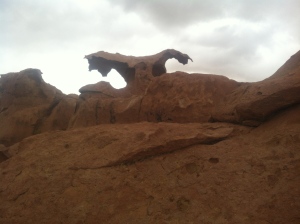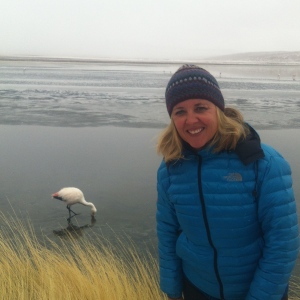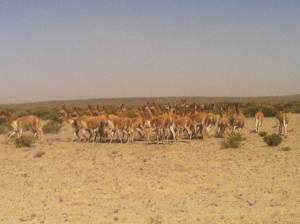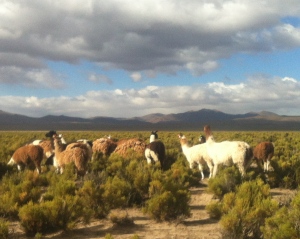Sucre
Sucre, the symbolic heart of Bolivia (as it was here that independence was proclaimed) is a real showpiece of a city. Declared a UNESCO World Heritage Site in 1991, the nation’s capital has a rich historical past that is reflected in its many whitewashed buildings, churches and mansions. Sucre is one of the most representative colonial cities of America and during its time, it was very much a Spanish one.
The multitude of narrow, quaint streets gives the city a definite European feel. And, we instantly fell in love with the beauty and warmth of this ancient South-American town (how delightful to wear our sandals again!). Sucre’s lower elevation of about 2800 metres (compared to La Paz) and its beautiful valley setting (surrounded by low mountains) give it its wonderful temperate climate.
The city is also known for its culture and art. Our hostel; Hostal CasArte Takubamba was decorated with numerous original art works (made by the establishment’s owner). It was a nice hide-away place for a week as it had a wonderful courtyard to enjoy meals (with new friends) and a spunky black whisky dog that the kids adored.
One of the art pieces at Hostal CasArte Takubamba
Festival de Teatro Escenctual Boliviano
We were lucky to be in Sucre during the time of “Festival de Teatro Escenactual”; a local film and theatre festival. Anthony’s love of the theatre compelled him to attend one of the plays called “El Pacto” (the pact); a funny staging about a research couple making a pact to research “love” but then fall for each other in the process.
Anthony really enjoyed his evening (although he had to concentrate to get all the finer details in Spanish). But then, to his delight, he found the play’s director Fernando Arze, and principal actress Andrea Ibanez Pantoja at our hostel’s breakfast table the next morning. This of course sparked a stimulating conversation about the intricacies of the play and theatre in general.
Anthony and with his theatre friends from El Pacto; Director Fernando, actress Andrea and technician Brian.
Dinosaurs
However, it was not the art but Sucre’s dinosaur discoveries that intrigued the children. This town actually offers evidence of their existence – how cool is that? So off we where to Parque Cretácico!
The Cretaceous Park is home to the largest paleontological site in the world and it’s here that you can see the largest collection of dinosaur tracks. We were excited!
For starters, the entrance had welcoming dinosaur heads. And, included with our admission was a complimentary guided tour. But first, we sat down and watched the BBC production: “Walking with Dinosaurs” which was quite informative (I’ve never seen the kids sit so still for 1 hour – they were intrigued!).
At the entrance of Parque Cretácico!
Then, we strolled the outdoor exhibit that showed life-size replicas of various dinosaurs, complete with recorded sounds of ferocious roaring (the replicas were apparently made by sculptors who worked under the direction of renowned scientists). There was one HUGE dinosaur (couldn’t even take a picture of it – it was so big); apparently the largest replica in the world, of an impressive Titanosaurus. Now we have some impressive dinosaur replicas at our Royal Ontario Museum (ROM) in Toronto and perhaps our friend Kiron Mukherjee from ROM Kids (http://romkids.tumblr.com) can confirm/deny who has the biggest replica but nevertheless, it was a cool, large dino!
Ps: Emile and Filou are writing regular posts for ROM kids about their world travels (with Kiron as their cool, encouraging mentor!)
Life size dinosaur replica
Finally, we got to see the massive limestone cliff that reveals 5055 dinosaur tracks of at least 8 species. There are even continuous tracks from a mid sized carnivore, which apparently is a world record. Definitely, a very unique site!
Limestone cliff that reveals 5055 dinosaur tracks from at least 8 different species
Dinosaur footprint
Origenes Cultural Show
On our last night in Sucre, we took in some local culture and attended the Origenes – Espacio Cultural (http://www.origenesbolivianos.com)Folklore show.
This 2-hour performance featured many of the traditional Bolivian dances, plus a theatrical rendition of Bolivia’s colonial history. The children loved it as the show was very colorful and gave us the opportunity to see some of Bolivia’s elaborate Carnival and dance costumes, as well as many cool moves (especially by the male dancers)!
Origenes; a Bolivian Folklore Show
Uyuni Salt Flats
After our relaxing days in Sucre, it was time for a long bus ride to get to the Uyuni Salt Flats. We chose Red Planet Expedition (www.redplanetexpedition.com) for our 3-day, 2-night tour. Together with our funny driver Pepe, informative guide Carlos and fellow world-travellers Pierre and Isabelle from Lille, France we set off in our packed, white, 4×4 for adventure.
Our 4×4
Salar de Uyuni is the world largest salt flat at 10,582 km2 (4,086 square miles) – it’s huge and so impressive! The salt flats are part of the Altiplano of Bolivia that is a high plateau that was formed during an uplift of the Andes Mountains. This plateau includes fresh and saltwater lakes as well as salt flats – and is surrounded by the most stunning mountains and semi-active volcanoes.
Semi-active Volcano
It is estimated that Salar de Uyuni contains 10 billion tonnes of salt, of which less than 25,000 tonnes is extracted annually. The plateau is covered by a few metres of salt crust, which has an extraordinary flatness – with average altitude variations within one metre over the entire area of the Salar. The crust serves as a source of salt and covers a pool of brine, which is exceptionally rich in lithium. It contains 50 to 70% of the world’s lithium reserves (used to make such things as car and cell phone batteries).
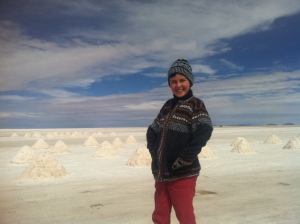
Emile with piles of salt
The incredibly large area of the Salar de Uyuni with its clear blue skies, and exceptional flatness of surface make it an ideal object for funny perspective photos (there is a mirror like effect as if you were standing on sheets of ice). As we took too many funny and beautiful shots, a separate photo blog will be dedicated to the Salt Flats, but for now here is Filou’s favorite picture:
Filou crushing his family
After some fun picture taking time, we moved onto Inca Huasi Island or Fish Island (due to its shape), which houses about 4030 giant cacti.
These cacti grow at a rate of about 1 centimetre per year to a height of about 12 metres (39 feet)! The hike to the top of this island gave us a remarkable 360-degree view of the amazing Salt Flats.
Emile on Inca Huasi Island that houses 4030 giant cacti
In the desert wastelands that surround the Salar, we also saw some interesting rock formations that had eroded, shaped by the wind and rain over time.
Rock formation looking like a condor
And of course, we saw the pink flamingos. There are about 80 species of birds in the National Park but the flamingos are the most common. There are 3 types of them; the Chilean Flamingo, the Andean and the James Flamingo – all of them get the pink colour in their plumage due to the red algae they eat.
Here is me with a James Flamingo (soft pink with a black tail):
With a James Flamingo
And of course, we saw several llama and vicuna herds roaming the plains.
Herd of Vicunas
And llamas
Due to some unexpected, severe weather (snow and hail), the last two days of our tour kind of bombed. Although we stayed in a fun salt hotel (where everything from the walls, to the tables and chairs were made of hardened salt) and made some great connections with the other group members on the tour (Filou was the evening’s entertainment with his wide range of jokes), we were absolutely freezing and ready to get back.
We had the option to get get dropped off at the Chilean border, and although that sounded very tempting, our flight to Ecuador made more sense from La Paz. Therefore, we took the very bumpy, Todo Turismo Bus (http://www.todoturismo.bo/?&lang=en) ride back during the night to the capital city of Bolivia. And it is from here that we are taking a flight to our 15th and last country.
Ecuadorian beach and Galapagos Islands, here we come!

